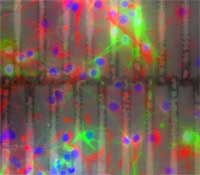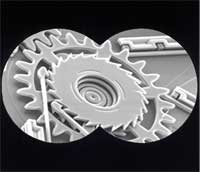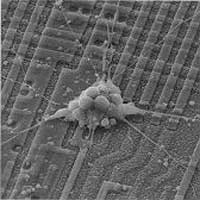Showing Spotlights 2481 - 2488 of 2838 in category All (newest first):
 If you have been an investor in nanotechnology companies and been lured by the promised riches, the picture doesn't look very pretty right now. We have updated our Nanotechnology Stock Index Performance chart, that we first showed six months ago, and the performance gap between the Dow Jones and the nanotechnology index funds has widened significantly (it looks even worse if you replace the Dow Jones industrial Index with a broad market index such as the Russell 2000). Of course, individual nanotechnology stocks have done better, but then, some have done much worse. That brings us to the question: What will it take for nanotechnology, taken as a set of enabling technologies, to realize its disruptive potential and create value for nanotechnology companies? An interesting answer can be found in an analysis of the recent Unidym and Carbon Nanotechnologies merger. Growth in the sector through consolidation may enable the creation of companies with the critical mass necessary to finally get public investors really excited about nanotechnology.
If you have been an investor in nanotechnology companies and been lured by the promised riches, the picture doesn't look very pretty right now. We have updated our Nanotechnology Stock Index Performance chart, that we first showed six months ago, and the performance gap between the Dow Jones and the nanotechnology index funds has widened significantly (it looks even worse if you replace the Dow Jones industrial Index with a broad market index such as the Russell 2000). Of course, individual nanotechnology stocks have done better, but then, some have done much worse. That brings us to the question: What will it take for nanotechnology, taken as a set of enabling technologies, to realize its disruptive potential and create value for nanotechnology companies? An interesting answer can be found in an analysis of the recent Unidym and Carbon Nanotechnologies merger. Growth in the sector through consolidation may enable the creation of companies with the critical mass necessary to finally get public investors really excited about nanotechnology.
Jul 26th, 2007
 Finding out how much power all the computers in the U.S., not to mention the world, are using seems to be an impossible task. We tried. The latest data from the Department of Energy (DoE) for household computer use is from 2001, for office use, from 1999. This is strange because when you do some back of the envelope calculations you arrive at some pretty staggering numbers. An estimated 1 billion computers in 2008 will use some 200 billion kWh of electricity (that's roughly what all households in New York City combined use over five years), generating about 127 million tonnes of CO2 in the process. And that's just for desktop and laptop computers, not including peripherals or the billions of chips used in other electronic devices. Researchers are now proposing to build a fully mechanical computer based on nanoelectromechanical (NEMS) components that would use considerably less energy. Inspired by a classical mechanical computer design from 200 years ago, the main motivation behind constructing such a computer is threefold: (1) mechanical elements are more robust to electromagnetic shocks than current dynamic random access memory (DRAM) based purely on complimentary metal oxide semiconductor (CMOS) technology, (2) the power dissipated can be orders of magnitude below CMOS and (3) the operating temperature of such an NMC can be an order of magnitude above that of conventional CMOS. Today, such a mechanical computer is only a hypothetical device. However, any effort to reduce the power consumption of computers, and not increase them as happens with every new chip generation, seems like a worthwhile effort.
Finding out how much power all the computers in the U.S., not to mention the world, are using seems to be an impossible task. We tried. The latest data from the Department of Energy (DoE) for household computer use is from 2001, for office use, from 1999. This is strange because when you do some back of the envelope calculations you arrive at some pretty staggering numbers. An estimated 1 billion computers in 2008 will use some 200 billion kWh of electricity (that's roughly what all households in New York City combined use over five years), generating about 127 million tonnes of CO2 in the process. And that's just for desktop and laptop computers, not including peripherals or the billions of chips used in other electronic devices. Researchers are now proposing to build a fully mechanical computer based on nanoelectromechanical (NEMS) components that would use considerably less energy. Inspired by a classical mechanical computer design from 200 years ago, the main motivation behind constructing such a computer is threefold: (1) mechanical elements are more robust to electromagnetic shocks than current dynamic random access memory (DRAM) based purely on complimentary metal oxide semiconductor (CMOS) technology, (2) the power dissipated can be orders of magnitude below CMOS and (3) the operating temperature of such an NMC can be an order of magnitude above that of conventional CMOS. Today, such a mechanical computer is only a hypothetical device. However, any effort to reduce the power consumption of computers, and not increase them as happens with every new chip generation, seems like a worthwhile effort.
Jul 25th, 2007
 Just a few days ago we ran a Spotlight on nanobionics that addressed some of the issues of bridging the interface between electronics and biology. Today we'll take a look at some leading edge research in the field of neural engineering - an emerging discipline that uses engineering techniques to investigate the function and manipulate the behavior of the central or peripheral nervous systems. Neural engineering is highly interdisciplinary and relies on expertise from computational neuroscience, experimental neuroscience, clinical neurology, electrical engineering and signal processing of living neural tissue, and encompasses elements from robotics, computer engineering, neural tissue engineering, materials science, and nanotechnology. In order for neural prostheses to augment or restore damaged or lost functions of the nervous system they need to be able to perform two main functions: stimulate the nervous system and record its activity. To do that, neural engineers have to gain a full understanding of the fundamental mechanisms and subtleties of cell-to-cell signaling via synaptic transmission, and then develop the technologies to replicate these mechanisms with artificial devices and interface them to the neural system at the cellular level. The first steps toward precise, informative and biocompatible neural interfaces have been made already.
Just a few days ago we ran a Spotlight on nanobionics that addressed some of the issues of bridging the interface between electronics and biology. Today we'll take a look at some leading edge research in the field of neural engineering - an emerging discipline that uses engineering techniques to investigate the function and manipulate the behavior of the central or peripheral nervous systems. Neural engineering is highly interdisciplinary and relies on expertise from computational neuroscience, experimental neuroscience, clinical neurology, electrical engineering and signal processing of living neural tissue, and encompasses elements from robotics, computer engineering, neural tissue engineering, materials science, and nanotechnology. In order for neural prostheses to augment or restore damaged or lost functions of the nervous system they need to be able to perform two main functions: stimulate the nervous system and record its activity. To do that, neural engineers have to gain a full understanding of the fundamental mechanisms and subtleties of cell-to-cell signaling via synaptic transmission, and then develop the technologies to replicate these mechanisms with artificial devices and interface them to the neural system at the cellular level. The first steps toward precise, informative and biocompatible neural interfaces have been made already.
Jul 24th, 2007
 Forecasting technological developments is notoriously tricky. Many futurologists choose a safe 50 to 100 years timeframe to make sure they are dead, and the book royalties spent, when the forecasts are due (or they skip the science part altogether and write science fiction). A few months ago we introduced you to a "Detailed Roadmap of the 21st Century", a year by year bullet point list of notable advances expected to happen in the 21st century. There is no wiggling out - the names of the people or organization making a forecast is attached to it. Already there are some missed forecasts - 8 out of 13 since 2001. Then there is another type of forecast, favored by some consultants and investment advisors, that attempts to predict the dollar value of product markets within a timeframe much shorter than that of futurologists and sci-fi writers. Although this group of forecasters develops elaborate models and methodologies, the outcome is equally dubious. A third type of forecast might be the most useful; here, the input comes from the group of people who live and breath the technology every day - the companies developing, building and selling products and services. Of course, the focus of this type of forecast necessarily becomes increasingly blurry as well as it looks into the future, but it tends to avoid the hyperbole and a lot of the speculative nature of other types of forecast. A recent UK study provides a purely industry-led forecast for nanotechnologies and examines industry's existing opinion of the economic potential for nanotechnologies.
Forecasting technological developments is notoriously tricky. Many futurologists choose a safe 50 to 100 years timeframe to make sure they are dead, and the book royalties spent, when the forecasts are due (or they skip the science part altogether and write science fiction). A few months ago we introduced you to a "Detailed Roadmap of the 21st Century", a year by year bullet point list of notable advances expected to happen in the 21st century. There is no wiggling out - the names of the people or organization making a forecast is attached to it. Already there are some missed forecasts - 8 out of 13 since 2001. Then there is another type of forecast, favored by some consultants and investment advisors, that attempts to predict the dollar value of product markets within a timeframe much shorter than that of futurologists and sci-fi writers. Although this group of forecasters develops elaborate models and methodologies, the outcome is equally dubious. A third type of forecast might be the most useful; here, the input comes from the group of people who live and breath the technology every day - the companies developing, building and selling products and services. Of course, the focus of this type of forecast necessarily becomes increasingly blurry as well as it looks into the future, but it tends to avoid the hyperbole and a lot of the speculative nature of other types of forecast. A recent UK study provides a purely industry-led forecast for nanotechnologies and examines industry's existing opinion of the economic potential for nanotechnologies.
Jul 23rd, 2007
 Back in January, when the U.S. president announced his hydrogen fuel initiative and proposed to spend a total of $1.7 billion over the next five years to develop hydrogen-powered fuel cells, hydrogen infrastructure and advanced automotive technologies, he said that it will be practical and cost-effective for large numbers of Americans to choose to use clean, hydrogen fuel cell vehicles by 2020. According to the U.S. Department of Energy's (DOE) Hydrogen Program, the government's goal is to achieve "technology readiness" by around 2015 in order to allow industry to make decisions on commercialization by then. That's only eight years to go. Given where the technology is today, this goal seems very ambitious, to say the least. Nanotechnology could help speed up the journey to the hydrogen society, but it will take some sensational breakthroughs on the way. The three key areas for the vehicles (we will not touch on the infrastructure issues here) are clean - the emphasis is on clean - hydrogen production, hydrogen storage, and the fuel cell itself. We'll take a look at how nanotechnology will play a role in these areas.
Back in January, when the U.S. president announced his hydrogen fuel initiative and proposed to spend a total of $1.7 billion over the next five years to develop hydrogen-powered fuel cells, hydrogen infrastructure and advanced automotive technologies, he said that it will be practical and cost-effective for large numbers of Americans to choose to use clean, hydrogen fuel cell vehicles by 2020. According to the U.S. Department of Energy's (DOE) Hydrogen Program, the government's goal is to achieve "technology readiness" by around 2015 in order to allow industry to make decisions on commercialization by then. That's only eight years to go. Given where the technology is today, this goal seems very ambitious, to say the least. Nanotechnology could help speed up the journey to the hydrogen society, but it will take some sensational breakthroughs on the way. The three key areas for the vehicles (we will not touch on the infrastructure issues here) are clean - the emphasis is on clean - hydrogen production, hydrogen storage, and the fuel cell itself. We'll take a look at how nanotechnology will play a role in these areas.
Jul 19th, 2007
 Following up on yesterday's Nanowerk Spotlight on nanobionics, today we'll look at bionics and other nanotechnology applications that could benefit disabled people. A range of applications and products with a combination of nanotechnology, biotechnology, and information technology are under development to directly improve the lives of people with severe injuries or medical conditions. Solutions range from better implants and prosthetics to brain-machine interfaces and they already are in the early stages of development and have working prototypes. While these are technical solutions to medical issues, and also a potential path towards transhumanist dreams, there is a number of social issues surrounding them that are rarely discussed. For instance, some 180 million young people between the ages of 10-24 live with a physical, sensory, intellectual or mental health disability significant enough to make a difference in their daily lives. The vast majority of these young people, some 150 million (80%) live in the developing world. They have limited access to education, employment and basic health care, and generally experience profound economic and social exclusion. The question needs to be asked whether the nano- and biotechnologies discussed to help the developing world are designed in a way to take into account the specific needs and realities of disabled people. Even if they did - and they do not - the next question is whether all these wonderful new technologies are really affordable for developing countries, or in other words: who pays for them? And finally, does the right social framework exist to take advantage of them?
Following up on yesterday's Nanowerk Spotlight on nanobionics, today we'll look at bionics and other nanotechnology applications that could benefit disabled people. A range of applications and products with a combination of nanotechnology, biotechnology, and information technology are under development to directly improve the lives of people with severe injuries or medical conditions. Solutions range from better implants and prosthetics to brain-machine interfaces and they already are in the early stages of development and have working prototypes. While these are technical solutions to medical issues, and also a potential path towards transhumanist dreams, there is a number of social issues surrounding them that are rarely discussed. For instance, some 180 million young people between the ages of 10-24 live with a physical, sensory, intellectual or mental health disability significant enough to make a difference in their daily lives. The vast majority of these young people, some 150 million (80%) live in the developing world. They have limited access to education, employment and basic health care, and generally experience profound economic and social exclusion. The question needs to be asked whether the nano- and biotechnologies discussed to help the developing world are designed in a way to take into account the specific needs and realities of disabled people. Even if they did - and they do not - the next question is whether all these wonderful new technologies are really affordable for developing countries, or in other words: who pays for them? And finally, does the right social framework exist to take advantage of them?
Jul 18th, 2007
 In case you are not old enough to remember the TV series The Six Million Dollar Man during the 1970s, the show was about an astronaut, Steve Austin, who got severely injured during a crash and became a guinea pig for bionics experiments by the CIA. In an operation that cost six million dollars, his right arm, both legs and the left eye are replaced by bionic (cybernetic) implants that vastly enhanced his strength, speed and vision. Never mind Hollywood, though, but bionics - a word formed from biology and electronics - has become a serious research field. In particular the development of artificial muscles is progressing rapidly. Nature's solution to producing fast contracting muscles is to use nanotechnology. The challenge for scientists is to mimic the intricacy of natural muscle in their artificial-muscle systems. As material scientists and engineers delve into the nanodomain, the boundaries between electronics and biology become fuzzy and this is exactly what they want: a seamless transition between the hard world of electronics and the soft world of biology.
In case you are not old enough to remember the TV series The Six Million Dollar Man during the 1970s, the show was about an astronaut, Steve Austin, who got severely injured during a crash and became a guinea pig for bionics experiments by the CIA. In an operation that cost six million dollars, his right arm, both legs and the left eye are replaced by bionic (cybernetic) implants that vastly enhanced his strength, speed and vision. Never mind Hollywood, though, but bionics - a word formed from biology and electronics - has become a serious research field. In particular the development of artificial muscles is progressing rapidly. Nature's solution to producing fast contracting muscles is to use nanotechnology. The challenge for scientists is to mimic the intricacy of natural muscle in their artificial-muscle systems. As material scientists and engineers delve into the nanodomain, the boundaries between electronics and biology become fuzzy and this is exactly what they want: a seamless transition between the hard world of electronics and the soft world of biology.
Jul 17th, 2007
 By now we all are aware of the issues concerning greenhouse gases and climate change, so there is no need to repeat them here. Rather, we will take a look at the areas where nanotechnologies could have a beneficial environmental impact - especially with regard to reducing greenhouse gases - above current technologies, and the barriers potentially preventing their adoption. A study commissioned by the nanotechnology group of the UK's Department for Environment Food and Rural Affairs (Defra) looked into the the policy implications of nanotechnologies that will benefit the environment. The report of the study, "Environmentally beneficial nanotechnologies: barriers and opportunities", investigates the opportunities and potential obstacles to adoption of a number applications of nanotechnology which could be used to cut use of non-renewable energy sources and reduce greenhouse gas emissions. Five nanotechnology applications were subject to detailed investigation: fuel additives, solar cells, the hydrogen economy, batteries and insulation.
By now we all are aware of the issues concerning greenhouse gases and climate change, so there is no need to repeat them here. Rather, we will take a look at the areas where nanotechnologies could have a beneficial environmental impact - especially with regard to reducing greenhouse gases - above current technologies, and the barriers potentially preventing their adoption. A study commissioned by the nanotechnology group of the UK's Department for Environment Food and Rural Affairs (Defra) looked into the the policy implications of nanotechnologies that will benefit the environment. The report of the study, "Environmentally beneficial nanotechnologies: barriers and opportunities", investigates the opportunities and potential obstacles to adoption of a number applications of nanotechnology which could be used to cut use of non-renewable energy sources and reduce greenhouse gas emissions. Five nanotechnology applications were subject to detailed investigation: fuel additives, solar cells, the hydrogen economy, batteries and insulation.
Jul 16th, 2007
 If you have been an investor in nanotechnology companies and been lured by the promised riches, the picture doesn't look very pretty right now. We have updated our Nanotechnology Stock Index Performance chart, that we first showed six months ago, and the performance gap between the Dow Jones and the nanotechnology index funds has widened significantly (it looks even worse if you replace the Dow Jones industrial Index with a broad market index such as the Russell 2000). Of course, individual nanotechnology stocks have done better, but then, some have done much worse. That brings us to the question: What will it take for nanotechnology, taken as a set of enabling technologies, to realize its disruptive potential and create value for nanotechnology companies? An interesting answer can be found in an analysis of the recent Unidym and Carbon Nanotechnologies merger. Growth in the sector through consolidation may enable the creation of companies with the critical mass necessary to finally get public investors really excited about nanotechnology.
If you have been an investor in nanotechnology companies and been lured by the promised riches, the picture doesn't look very pretty right now. We have updated our Nanotechnology Stock Index Performance chart, that we first showed six months ago, and the performance gap between the Dow Jones and the nanotechnology index funds has widened significantly (it looks even worse if you replace the Dow Jones industrial Index with a broad market index such as the Russell 2000). Of course, individual nanotechnology stocks have done better, but then, some have done much worse. That brings us to the question: What will it take for nanotechnology, taken as a set of enabling technologies, to realize its disruptive potential and create value for nanotechnology companies? An interesting answer can be found in an analysis of the recent Unidym and Carbon Nanotechnologies merger. Growth in the sector through consolidation may enable the creation of companies with the critical mass necessary to finally get public investors really excited about nanotechnology.
 Subscribe to our Nanotechnology Spotlight feed
Subscribe to our Nanotechnology Spotlight feed





